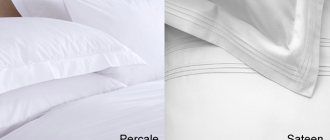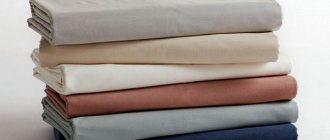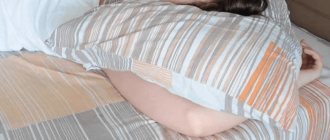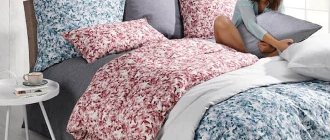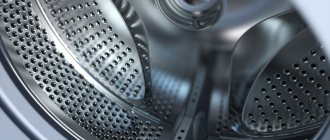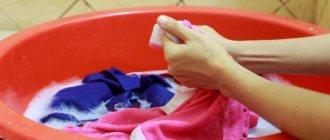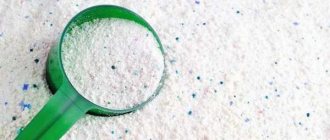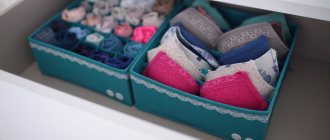Everyone knows that comfort lies in the little things: a favorite photo in a frame, a cute figurine on the chest of drawers, bright pillows on the sofa - the list of elements that make our home a real home is endless.
But there are things hidden from the view of outsiders, but this does not make them any less important. One of these things is bed linen. You need to choose it carefully and carefully. Appearance plays a very important role, but quality is no less important.
Today, store shelves are literally littered with a variety of bedding sets - they all differ not only in size and colors, but also in material.
In this article, we will compare two popular fabrics - percale and calico, and consider their pros and cons, composition, types and methods of caring for them. In addition, we will try to explain in as much detail as possible how percale differs from calico, so that you can accurately decide for yourself which of these fabrics is more suitable for your family.
Features of percale bed linen
For many, the name “percale” sounds like something exotic and incomprehensible. In fact, percale is an ordinary cotton fabric. Well, not quite ordinary... Although percale is made from long-staple cotton, this fabric does not at all look like the chintz or linen we are all familiar with. The front side of percale is smooth and silky, with a tactile sensation very reminiscent of natural silk. In addition, the distinctive properties of this fabric include:
- Increased strength
- Very high density
- Good wear resistance
- Huge selection of colors and designs
- Eco-friendly and hypoallergenic
An undeniable advantage of percale is that it does not shrink even after washing at high temperatures.
One hundred percent cotton percale is an expensive material. In order to make this fabric more accessible, manufacturers often include a certain percentage of synthetics in the composition.
Let’s say right away that percale with an admixture of polyester is much cheaper, but its quality characteristics are in many ways inferior to “pure” ones - it is not so durable, dense and beautiful, after several washes it loses its appearance and becomes highly electrified.
Luxury bed linen is sometimes sewn from a special percale - cotton with the addition of silk or linen threads. Naturally, such kits look very expensive, and they are not cheap.
Types of percale:
- Technical.
Used for sewing tents, parachutes, awnings and special industrial covers. The high wear resistance of this type of percale is achieved thanks to special treatment of the fabric - it is impregnated with special compounds that make it not only durable, but also very dense, practically impermeable to moisture and dust. - Domestic.
Judging by the name, it is easy to guess that this type of percale is used for domestic purposes: for sewing bed linen, clothing, table textiles (tablecloths, napkins, etc.).
The soft semi-matte texture gives percale its impeccable appearance: this slight shine is the result of a special chemical treatment of the material. The threads on the front side of percale are treated with size - an adhesive composition that makes the fabric strong, smooth and silky.
As for satin, during its production a special satin weave is used, and the threads are strongly twisted - which is why this material has a beautiful shine.
Sale of bed linen sets
Best prices for bulk purchases
View in the catalog
Manufacturing Features
Manufacturers have not yet decided what genus the word “percale” refers to. In some countries, a special material made from laminated threads is called percale. The cotton is first washed and combed. When producing thin threads, loose cotton is treated with an environmentally friendly adhesive, which polymerizes during the drying process, forming a film in fractions of a micron. The process is called sizing; potato starch, lard, glycerin and other organic substances that do not contain phenols and formaldehyde are used to glue the fiber.
The canvases are painted at the final stage of production. Automatic machines transfer patterns of any complexity to weaving. Thanks to modern technologies, you can find home textiles of all kinds of colors, for children's and adult bedrooms.
The usual weaving is used: the weft thread intersects with the warp. Depending on the thickness of the threads, you can obtain products of any density. They create percales for parachutes; with a small volume, the fabric exhibits low throughput. For thin percales, from which bedding is sewn, thread numbers 60...100 are used. Medium-density types of fabric are woven from threads No. 36...60. Such woven products are noticeably heavier and not as airy.
Important! Unscrupulous manufacturers use regular threads instead of sizing threads, then sand the finished fabric. This fabric wrinkles a lot under your hand.
Features of calico bed linen
Calico is a thick cotton fabric with a simple plain weave.
In Russia, this material began to be produced in the 16th century, and before that it was brought from Asian countries. Initially, calico was used exclusively for sewing outerwear, but later, thanks to the improvement of production, underwear and bed linen began to be sewn from it.
Calico is woven from cotton threads, but in many countries the use of synthetic fibers in the production process of this material is allowed. Naturally, polyester or polyester does not add positive qualities to calico: such fabric quickly loses its appearance, wears out after several washes, sheds very much and becomes electrified.
Types of calico:
- Harsh.
This is a rough, undyed canvas that is highly durable and dense. Naturally, such fabric is completely unsuitable for sewing bed linen. Most often, harsh calico is used for sewing workwear or rough upholstery of furniture. - Bleached.
This calico undergoes a special treatment - bleaching with special compounds. It is less dense than harsh. This fabric is used to make cheap bed linen for hospitals, military units, medical clothing, army linen, and table textiles. - Plain painted.
In terms of density, this calico does not differ from bleached calico. Plainly dyed calico is dyed in different colors - this fabric is actively used for sewing bedding sets; in addition, it is ideal as a lining fabric for suits or outerwear. - Printed.
The bright, beautiful designs of printed calico make it an ideal material for sewing bed linen (for both adults and children), pajamas, nightgowns, women's and men's underwear.
Among other things, there is a classification depending on the method of processing the threads - the most expensive is the so-called “Luxury” calico. For its production, well-processed thin threads are used. Calico of the “Comfort”, “Light” and “Standard” classes are more affordable fabrics. They are characterized by lower density and are used mainly for sewing garments.
High-quality calico made from 100% cotton has the following properties:
- High strength and density
- Wear resistance
- Maintaining original properties for a long time
- Ability to withstand multiple washes
- Hypoallergenic and safe for the environment.
Housewives will undoubtedly like the fact that calico is very easy to care for - standard washing, ironing, drying, there is no need to use special substances to treat the fabric and preserve its original appearance.
It is worth noting that for sophisticated buyers calico will seem too simple a fabric. Although bed linen sets made from this material are of very high quality, they are noticeably inferior in appearance to similar products made from satin, percale or poplin.
The main difference between percale calico is the use of threads of the same thickness in the weaving process (on the front and back sides), while in percale thin and smooth threads go to the front side, and thicker and denser ones go to the back side. In addition, the front side threads are treated with a special compound, so percale feels very similar to silk.
Comparison of density and softness
The density of both materials is almost the same. However, calico does not contain any chemical additives that would help increase density.
The fabric was originally developed for covering aircraft. Naturally, such super-strong material is not produced for household needs. However, the wear resistance of the fabric is increased by applying adhesive impregnation to the front side.
In terms of thread weave density, calico is classified as medium, with 45-46 threads per 1 cm2. Percale has high rates - 82-120 threads per 1 cm2.
In terms of softness, calico wins, even when it comes to harsh or bleached fabric. Over time, this fabric only becomes softer and develops a small pile.
How to distinguish percale from calico?
Let's start with the fact that both percale and calico are made by simple plain weave of threads.
In the process of making calico, threads of the same thickness are used. The technology for making percale is somewhat different - the front threads are thin, treated with a special adhesive, and the back threads are thick.
You can distinguish calico from percale by touch - percale is smoother, silkier and more delicate. Calico is more loose. External differences are also noticeable to the naked eye - percale is characterized by a beautiful semi-matte shine, while calico looks more simple and prosaic.
The differences between satin and percale are less pronounced - both fabrics have a smooth and silky top layer, while percale is rougher and denser than satin.
Which fabric is more expensive?
Based on all of the above, it is easy to guess that percale is much more expensive than calico. However, there are some nuances here too:
- Low-quality percale with an admixture of synthetics will be slightly cheaper than 100% luxury cotton calico.
- Calico woven from high-quality cotton threads will cost more than percale made from average quality raw materials.
Naturally, without certain knowledge and sufficient experience, it is very difficult to distinguish high-quality fabric from low-quality fabric. Therefore, when choosing a set of bed linen, you need to focus on reviews from other customers and choose only conscientious manufacturers who tremble with their reputation and sell only high-quality products.
The cost of a double set of percale bed linen is 5,000-7,000 rubles, while a similar set and connections will cost from 3,000 rubles.
Reviews
Reviews about the two fabrics are mostly positive. But buyers often prefer percale, it looks expensive, is easy to handle, and has a long service life.
The second material also looks good, especially plain-dyed and printed, but bed linen made from it is not so durable; after a few washes it is already noticeable that it is not new. But it doesn’t become so boring, since you have to change it more often. The most important thing is that both fabrics are natural and do not cause an allergic reaction.
Which fabric is stronger?
Both percale and calico are very durable, dense fabrics. However, percale still outperforms calico in wear resistance.
Initially, percale was developed as a fabric intended for covering aircraft hulls - there is no need to explain that this material has unsurpassed strength properties.
Of course, modern percale is not so super durable, however, the special cool impregnation of the face threads makes this fabric very wear-resistant.
As for calico, special chemical compounds are not used in the production of this material, so its strength is determined solely by the strength of cotton threads and dense plain weaving.
Percale manufacturers claim that such fabric can withstand up to 1000 washes without losing the original properties of the material. In other words, you are more likely to get tired of a percale bedding set than to become unusable.
Calico sheets, duvet covers and pillowcases can easily withstand 300 washes - in fact, this is quite enough, considering that on average bed linen is updated once every 3-5 years.
Which is easier to care for?
Both calico and percale do not require special care. This is because these are high quality cotton fabrics. However, percale can withstand much more washing than calico.
The rules for caring for these fabrics are simple:
- Wash at 40-60 degrees.
- Spin in the washing machine at 800 or 1000 rpm.
- Both calico and percale can be dried in the dryer.
- These fabrics can be ironed at a temperature of 150 degrees, slightly damp. If the material is completely dry, steam treatment can be used.
Products made from percale and calico do not shrink, so if necessary, plain-dyed or bleached products can be boiled.
It is worth saying that after numerous washes, percale becomes noticeably softer, but still not as soft as calico.
Flaws
It turns out that even the best fabrics are not perfect. For some consumers, the disadvantages of percales become significant:
- the material, unlike silk, has no shine and appears matte;
- the natural protection of the fiber is destroyed by chlorine-containing household chemicals, so you have to look for suitable products to remove stains;
- prices for products from Portugal, Italy, and other European countries are often deterred by their high cost; not everyone is willing to pay for quality;
- Due to its low hygroscopicity, the fabric does not absorb sweat and fat from the skin; in hot weather the sleeper will feel stuffy.
On a note. Percale is not used to care for a baby; the baby’s skin will become warm. Frequent heat treatment deteriorates the properties of textiles.
Which is better?
It is simply impossible to answer this question unambiguously. Each of us has our own concept of quality: some believe that a set of bed linen should, first of all, be beautiful, for some the main indicator is softness and tenderness, others like smoother and silkier linen.
Calico and percale are high-quality cotton fabrics. They are characterized by high wear resistance, excellent strength and good appearance.
If we put aside all the nuances and look at this issue objectively, we can conclude that percale, after all, is superior in quality to ordinary calico linen sets.
Comparing percale with poplin and satin
Percale, poplin and satin are cotton fabrics that have similarities and differences. All of them are quite popular and in demand when sewing bed linen.
The main difference between these fabrics is the type of weave of threads (satin weaving for satin, plain weaving using threads of different thicknesses for percale and poplin).
In addition, in the process of weaving satin, highly twisted threads are used, due to which the top layer of the fabric is smooth and slightly shiny.
Percale is superior in strength to both satin and poplin. In addition, this fabric is considered the most wear-resistant fabric of all the above.
The advantages of satin are its impeccable appearance, a large number of color options, a smooth surface to which dust and animal hair do not stick.
Poplin is favored by its low cost, good wear resistance and softness.
Questions and answers
What is the difference between percale and satin?
Satin is softer, has a more pronounced shine and smoothness. It is made from twisted yarn. The weft thread overlaps 4 or more warp threads.
What is the difference between percale and poplin?
Poplin is thicker and somewhat rougher. If you look at the fabric under a magnifying glass, the threads have different thicknesses - the weft is thick and looser, and the warps are thin and strong.
Despite its rustic appearance, calico is an undying classic. Percale looks more attractive and lasts longer. When choosing bed linen, you need to decide what is closer - practical simplicity or ultra-durability, nice appearance and softness, but at a higher price.
Comparing calico with poplin and satin
Calico and poplin are budget options for fabrics for sewing bed linen. They have good strength properties, can withstand a large number of washes, and are easy to care for. At the same time, calico is a denser material than poplin and satin.
As for the cost of fabrics, calico and poplin cost about the same, but satin is an expensive luxury fabric that looks much more presentable and richer.
Sale of bed linen sets
Best prices for bulk purchases
View in the catalog
Percale or calico, which is better to choose?
What should you pay attention to when choosing a bedding set made of percale or calico? Here are the main points:
- If the appearance of the linen is important to you (for example, you do not like to use a bedspread), then percale is your choice.
- For those housewives who prefer soft and delicate linen, calico is ideal. Percale, in turn, is denser, and thanks to the special treatment of the threads, it is quite smooth (by the way, this is an ideal option for summer - it is not hot on such underwear, it absorbs moisture well and allows air to pass through).
- Compound. You should not buy bed linen made from fabrics that contain synthetics - they will quickly lose their appearance, and it is not very pleasant to sleep on them.
| Calico (cotton, without polyester admixtures) | Percale (cotton, without polyester admixtures) | |
| Price | From 3000 to 7000 rubles | From 5000 to 7000 rubles |
| Strength | Withstands 300 washes | Withstands up to 1000 washes |
| Density | On average 120 – 145 g/m2 | On average 110-115 g/m² |
| Softness | The material is soft, slightly velvety, without silky gloss | The front surface is velvety, there is a slight semi-matte shine |
| Appearance | It looks simple, there are a large number of colors to choose from. | Compared to satin, it looks simpler and more restrained. |
| Care | Does not require special care, can be ironed at a temperature of 150 degrees, washed at a temperature of 40-60 degrees, you can use standard detergents. Does not shrink after washing at high temperatures. | It is advisable to iron percale bed linen slightly damp. Shrinks after washing at high temperatures. |
| Production | No chemical compounds are used in the production process. The weave is simple linen, made of threads of the same thickness. | During the production process, a special adhesive is used to make the fabric more durable. |
Subtleties of choice
For a comfortable sleep, you need to choose natural cotton. European manufacturers always include pieces of fabric so that each buyer can verify the peculiarities of the structure of textile products.
Percale sets must have a clear pattern, not blurred along the contour. Pastel shades and natural tones are trending. Multi-colored bright sets with funny animals or cartoon characters especially delight school-age children. This is the best linen option for winter. By the way, the color of percale on both sides is almost the same, this is explained by the good absorption of the dye.
You can often find plain products with lace inserts or frills. Embroidery looks great on thick fabric that shrinks slightly after washing. The size of the linen deserves attention; more often, manufacturers offer a Euro format; there are sheets with elastic and duvet covers with snaps.
Important! In retail there are mixed percale varieties. To reduce the cost of production, synthetics are added to cotton; the properties of such textiles are noticeably worse than those of natural ones. When purchasing, be sure to pay attention to the composition of the fabric.
Children love silky, warm percale underwear in beautiful colors.
